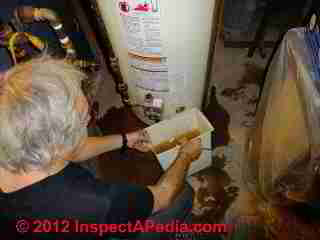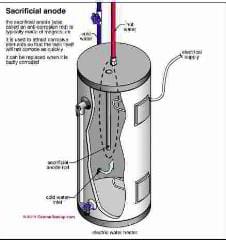 Hot Water Heater Anodes & Dip Tubes - Inspection, Diagnosis, & Repair
Hot Water Heater Anodes & Dip Tubes - Inspection, Diagnosis, & Repair
Water heater anode or water heater dip tube inspection & replacement
- POST a QUESTION or COMMENT about water heater anodes & dip tubes: water heater odors, corrosion, leaks, & tepid hot water troubleshooting
This article gives a definition of water heater anodes or dip tubes, explains what they are for, how they work, and what goes wrong with anodes and dip tubes.
A corroded or damaged dip tube or water heater anode can cause loss of hot water, water odors, and even debris showing up in the building water supply.
A bad water heater anode can produce a sulphur odor in hot water. A worn out water heater anode shortens water heater life. A leaky water heater dip tube can cause less hot water delivery to the home or debris in the water supply piping.
What is the difference between a water heater dip tube and the sacrificial anode? Are they the same part? How to inspect, diagnose, & replace water heater anodes and dip tubes.
The articles at this website will answer most questions about residential and light commercial water heaters as well as many other building plumbing system inspection or defect topics. Page top water heater drawing showing the sacrificial anode on a water heater is provided courtesy Carson Dunlop Associates, used with permission.
InspectAPedia tolerates no conflicts of interest. We have no relationship with advertisers, products, or services discussed at this website.
Check the Sacrificial Anode & Dip Tube of Your Water Heater Tank
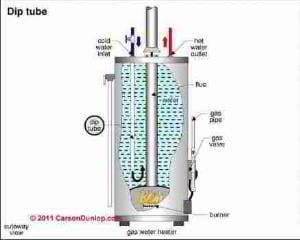 Reduced hot water pressure and flow and also sulphur smells or similar water odors in the hot water supply as well as debris in the water supply system might all be traced to problems with a water heater anode or dip tube.
Reduced hot water pressure and flow and also sulphur smells or similar water odors in the hot water supply as well as debris in the water supply system might all be traced to problems with a water heater anode or dip tube.
Accumulated debris in a water heater, and debris from a corroded or disintegrating hot water tank dip tube or hot water tank sacrificial anode can also block the hot water outlet opening, resulting in low hot water pressure in a building.
- To drain your water heater tank, for example to replace a part,
see WATER HEATER DRAIN PROCEDURE. - To flush accumulated crud or debris from a water heater (yearly maintenance)
see WATER HEATER FLUSH PROCEDURE - To de-scale or de-lime your hot water heater,
see WATER HEATER SCALE DE-LIMING PROCEDURE - To diagnose and repair a bad water heater dip tube or anode,
see WATER HEATER ANODES, DIP TUBES - To diagnose particulate debris in the building water supply, faucet strainers, etc. that comes from the hot water tank, and how to fix that problem,
see WATER HEATER DEBRIS FLUSH - To diagnose air bubbles at hot water outlets only (and perhaps odors in hot water)
See AIR DISCHARGE from HOT WATER
Below we discuss the water heater anode and water heater dip tube in detail. This article describes the diagnosis and cure of debris in the building water supply traced to a deteriorated water heater dip tube/anode.
Functions of a Water Heater Tank Dip Tube
The water heater tank dip tube, often made of a special metal to combine its function with that of a water heater tank sacrificial anode (to reduce water tank corrosion and leaks) performs these functions:
- Incoming cold water is placed at the bottom of the water heater tank, closest to the heating element or burner
- Incoming cold water does not dilute and cool down the outgoing hot water which by natural convection will normally rise and be found at the top of the hot water tank
- Corrosion protection: in some (not all) water heaters, construction of a hot water tank dip tube of an intermediate metal (perhaps zinc) will permit it to function as
a SACRIFICIALANODE [illustration] in the water tank to reduce the corrosive effects of hot water on the water tank body itself - this makes the water tank last longer.
We discuss the hot water tank sacrificial anode and dip tube in more detail below.
Functions of the Water Heater Anode
By inserting into the water heater tank a rod made of a metal which is more readily corroded than the steel of a steel hot water tank, the sacrificial anode protects the hot water tank from early failure due to corrosion.
An illustration of the water heater anode is shown at the top of this page.
Low Hot Water Temperature Traced to Depleted Combination Dip-Tube & Sacrificial Anode
At WATER HEATER TEMPERATURE TOO COLD or TOO HOT we explained that a leaky dip tube in a water tank can result in hot water temperatures that are too low.
But the dip tube on many water heaters also functions as a sacrificial anode, as we show here.
Here Carson Dunlop Associates' sketch shows the location of the sacrificial anode dip tube on an electric water heater.
Cold water is shown entering from a pipe behind the heater and entering at the bottom of the water tank.
But some water heaters use a "dip tube" that may also serve as the sacrificial anode.
Bad Dip Tube Can Mean Water Is Not Hot Enough
Watch out: another water heater defect can also result in hot water that's not hot enough.
If the dip tube in the water heater has fallen off or disintegrated, cold water will enter the water heater at its top rather than at its bottom.
The result will be constant dilution of the hottest water in the heater (at its top) with incoming cold water. The result is that the hot water may be just tepid, not hot enough, though the total quantity of hot water is unchanged.
Sulphur or Rotten Egg Smells in Hot Water Supply Traced to Water Heater Anode Problems
The role of the sacrificial anode is to protect a glass-lined steel water heater tank itself from corrosion - the water heater anode rod will gradually deteriorate or basically "dissolve" over the life of the water heater.
The rate of water heater anode depletion depends on the chemistry of the water supply (more aggressive water is more corrosive), and the amount of usage of the water heater - how much hot water is used in the building.
Watch out: if the water heater sacrificial anode rod completely dissolves or depletes, the water tank itself is no longer protected from corrosion and the tank may be damaged and its life significantly reduced.
If your hot water smells like rotten eggs, and especially if it's only the hot water, not also the cold water supply, you should definitely check the condition of the sacrificial anode on the hot water heater, no matter what kind of water tank you've got installed.
If the building water supply contains dissolved hydrogen sulfide gas (H2S), then the combination of water chemistry and the presence of the sacrificial anode in the water heater tank can produce black debris in the water supply and an increased level of sulphur or rotten egg smells in the building hot water supply.
Watch out: H2S is also potentially explosive - see details
In fact if there is significant H2S in the water supply even the cold water may smell like rotten eggs. In our experience with private well water that contained H2S, the odor level varied by time of year, level of the water table in the ground, and usage of the well.
Often returning from a month of vacation the homeowner would notice a stronger rotten egg smell in the building water supply.
If your water supply contains high levels of hydrogen sulfide, enough to smell, you should check with your plumber or your water heater manufacturer about purchasing and installing a special sacrificial anode that can reduce this smell problem in the building hot water system.
Additional water treatment to remove sulphur may also be needed.
Change to an aluminum anode in the water heater?
Aluminum anodes are used in water heaters to replace the standard magnesium anode where the local water supply is high in sulphur. That's to avoid a problem with the formation of hydrogen sulfide gas in the water heater - a rotten egg smell.
Watch out: if your water supply is both high in sulplhur and is alkaline, a reaction between alkaline water and an aluminum water heater anode can cause the formation of blue-green slime or gel deposits that can ultimately clog the hot water supply piping system.
If you experience that problem your water supply may need to be tested to confirm its alkalinity. You might need to install a treatment system to adjust the pH of your water supply.
Corrosive Water Supply Reduces Anode & Water Heater Tank Life
If your water supply happens to be highly conductive or corrosive then the dip tub/sacrificial anode in the water tank may indeed corrode away until it leaks (dropping the hot water temperature) or disappears entirely.
See details at WATER TESTING GUIDE
Another cause of H2S odors in hot water may be traced to homes that use a water softener to treat their incoming water supply.
Water that is high in salt ions (a water softener may replace calcium or magnesium with sodium or salt ions in the process of "softening" a hard water supply), can be extra corrosive in the water heater and can reduce the life of both the sacrificial anode and the water heater tank itself.
At ODORS in WATER we discuss the general problem of diagnosing and curing odors in water;
We provide a detailed list of sewer and sulphur gas odor sources
at SOURCES OF SULPHUR ODORS IN BUILDINGS.
Also CHINESE DRYWALL HAZARDS discusses Chinese drywall odors, sulphur smells, and corrosive outgassing hazards in buildings.
Major costs to remove this product, repair or replace electrical wiring, plumbing, and HVAC components may be involved, and there may be immediate safety hazards due to damaged smoke detectors or carbon monoxide detectors in buildings where Chinese drywall outgassing has caused damage.
Procedure to inspect a water heater Sacrificial Anode or Dip Tube
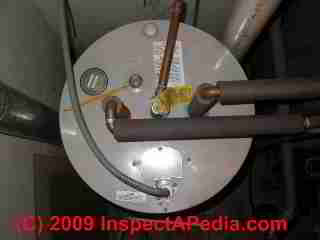
In our photo (left) our pencil is pointing to the water heater sacrificial anode fitting, viewed looking down on the top of the water heater. Often the word "anode" will be found embossed into the steel water heater top at this location.
In this case the sacrificial anode is a separate component that can be removed and replaced on the water heater tank.
The dip tube, not directly visible, is below that blue plastic ring that marks where cold water is entering the water heater tank.
Regardless of whether your water heater is electric, gas fired, oil-fired, or indirect fired from another heat source the sacrificial anode inspection and change out procedure is similar. We outline the procedure below.
For details also
- Turn off the water heater
- Close the cold water valve that lets water enter the water heater tank
- Open a nearby hot water faucet to relieve water pressure in the water tank.
- Remove the sacrificial anode - which may mean removing the combined dip-tube/sacrificial anode at the top of the water heater tank.
On many water heaters the dip tube, used to direct incoming cold water to the bottom of the water heater tank, is also the sacrificial anode. So disconnecting some plumbing fittings at the cold water inlet may be needed. - Install a new sacrificial anode in your hot water heater tank - be sure that your plumbing connections are properly cleaned and doped (or use teflon tape) - so that you won't have to do this procedure all over again.
How Often Should the Water Heater Sacrificial Anode be Inspected?
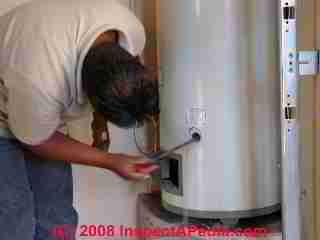 Water heater installation guides we surveyed gave water heater anode rod inspection (and replacement if needed) intervals of 3 to 10 years, probably varying by water heater type and model and anode rod properties as well.
Water heater installation guides we surveyed gave water heater anode rod inspection (and replacement if needed) intervals of 3 to 10 years, probably varying by water heater type and model and anode rod properties as well.
American Water Heater Co. recommends that the water heater sacrificial anode rod should be removed from the water heater tank every three years for inspection, and if the rod is more than 50% depleted it should be replaced.
If the water heater is installed in an area where the water is hard, or "aggressive" or "corrosive", inspect the water heater after 3 years, or for Rheem water heaters, every 5 to 8 years.
Rheem Corporation, a manufacturer of water heaters, recommends that the water heater anode be inspected after 8 years (Rheemglas™, RheemPlus™) to 10 (Rheem Optima) years depending on the water heater model.
Aluminum Water Heater Anodes & Alkaline or high pH water Causes Slime Formation
Inspect the water heater for deposits of a gelatinous Aluminum hydroxide (Al OH) slime at the heater drain, on the anode, and slime clogs at faucet strainers if you live in an area where water is acidic, and in particular if your water heater uses an aluminum anode.
The result can be a rumbling or popping noise that may occur while the water heater is still rather new, with less than six months of service.
At RUMBLING WATER HEATER we explain that when the water supply has a high pH (pH of 8 or higher) and where the sacrificial anode in the water heater is made of aluminum. High pH means the water is too alkaline or too basic (not acidic enough).
The high pH water reacts chemically with aluminum to form aluminum hydroxide (Al OH) that appears as a blue, gray or green slimy substance collecting on the bottom of the water tank as well as on the surface of the sacrificial anode.
That slime can cause both rumbling noises in the water heater - similar to those caused by scale deposits, and clogging water faucets if the heater uses an aluminum anode.
The proper repair is to flush the water heater thoroughly and then to replace the aluminum anode with a magnesium sacrificial anode.
Is the Anode Aluminum or Magnesium?
On some water heaters such as those produced by A.O. Smith, you can identify an aluminum sacrificial anode by noticing that its capping plug surface is smooth. A magnesium anode plug or cap has a weld bead on the plug.
- AOS Bulletin 14 ALUMINUM HYDROXIDE [PDF] for a description of cures for aluminum hydroxide slime clogging if no mineral scaling is also present, retrieved 2017/11/17 original source: https://www.hotwater.com/lit/bulletin/bulletin14.pdf
There the company notes:
Since aluminum hydroxide is a product of a chemical reaction dependent on the water condition, any treatment is not considered warranty related.
How to Replace the Water Heater Anode Rod - step by step
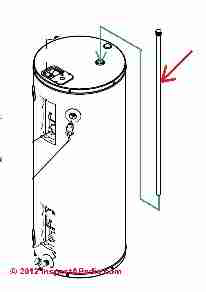 On inspection, if your water heater sacrificial anode is corroded and pitted, or if the lower portion of it has dissolved completely, the anode needs to be replaced and you will need to shorten the interval at which you inspect this component.
On inspection, if your water heater sacrificial anode is corroded and pitted, or if the lower portion of it has dissolved completely, the anode needs to be replaced and you will need to shorten the interval at which you inspect this component.
It's a relatively small plumbing job to disconnect water pipes from the water heater and then pull and check, and replace the dip tube/sacrificial anode if necessary.
A great time to change the water heater dip tube or anode is when the water heater tank has been drained for some other reason, such as to de-scale or de-lime the water heater (as the worker is doing in our photo at left) -
see WATER HEATER SCALE DE-LIMING PROCEDURE.
Safety Warning: do not attempt to de-lime or de-scale an electric water heater without first making sure that the de-scaling chemical won't contact the sacrificial anode - otherwise an explosion or fire could occur.
The water heater anode location, for purposes of removal or replacement on most water heaters is accessed from the water heater tank.
In our sketch of a water heater showing the anode location, the anode (red arrow) is inserted into the water heater tank top at the spot pointed to by the green arrow.
Usually this location is marked on the water heater top as "Anode".
 Here are the detailed steps in replacing a water heater anode rod:
Here are the detailed steps in replacing a water heater anode rod:
- The water heater is turned off.
- Turn off the cold water supply line that enters the water heater tank.
- Open a nearby hot water faucet to remove pressure from the water heater tank.
- Attach a garden hose to the water heater tank drain valve - found near the bottom of the water heater tank. Route the hose outdoors or to a convenient floor drain.
- You can route the hose to a nearby sink only if the height of the sink edge (over which the hose has to pass) is a couple of feet lower than the top of the water heater tank.
A higher hose destination will prevent the water heater tank from draining.
If your water heater drain valve happens to be high enough above the floor you can skip the hose hookup and just use a plastic pan or bucket as we show in our photo (below).
- Using the water heater drain valve we just described, drain five gallons of water out of the heater.
- Close the water heater drain valve.
- Remove the anode rod - you'll see on most newer water heaters that the anode rod is a separate device from the dip tube - so you won't have to disconnect the cold water supply piping. Instead take a look at the top of the water heater and you'll see a hexagonal head marked "Anode".
- Unscrew the rod and using teflon tape or pipe dope, screw in its replacement.
- Open the cold water supply to the water heater and check for leaks.
- Turn the water heater power back on.
Some water heaters do not have a sacrificial anode rod. Instead these water heaters may use a chemically inert anode rod to which electrical power is provided to achieve the same anti-corrosion function.
Be sure to disconnect the anode rod electrical power before attempting water heater cleaning, and be sure to restore power after the tank is returned to operation.
Also see WATER HEATER FLUSH PROCEDURE where we describe the effects of a deteriorated plastic water heater dip tube.
How Long Should A Water Heater Last?
See AGE of WATER HEATERS for the answer as well as for our list of factors that affect water heater life.
Also see our list of types of water heater leaks
Reader Comments, Questions & Answers About The Article Above
Below you will find questions and answers previously posted on this page at its page bottom reader comment box.
Reader Q&A - also see RECOMMENDED ARTICLES & FAQs
On 2020-02-01 by (mod) - what's this debris in the water heater?
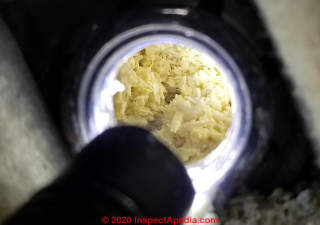 That looks like an accumulation of fragments of mineral scale, Jo.
That looks like an accumulation of fragments of mineral scale, Jo.
The other possibility (less likely in this case based on the crystalline appearance of your white fragments) is a deteriorated white plastic dip tube in the water heater.
Above in the more reading ARTICLE INDEX section you'll want to review
WATER HEATER DEBRIS FLUSH
WATER HEATER FLUSH PROCEDURE
WATER HEATER SCALE DE-LIMING PROCEDURE
I've also seen water heater debris like that when the dip tube or sacrificial anode have deteriorated - showing up also as debris clogging sink faucet strainers and shower heads.
It would be helpful if you could tell me thorugh what opening you are viewing that white debris in your water heater.
On 2020-02-01 by Jo
I been having some issues with my water heater and been going through helmets like every 6 months and just this week I changed again but found some particles inside tank I attached pic
On 2019-11-27 by (mod) -
Bill said:
Have you ever tried electric anode rod? Just bought a Corroprotect couple months ago and it works very well.
On 2018-09-10 by (mod) -
Thank you for your thoughts on this, Don.
The bacteria in a water heater might be harmless as you suggest, or not, depending on the specific genera species: there are more than one bacteria that might be found in a water heater. Common is an anerobic bacteria, also a sulphate-reducing bacteria producing H2S - Hydrogen Sulfide (rotten egg smell). As you cited, these two most-common bacteria are considered a nuisance (smelly) rather than a health hazard.
Watch out however: the assertion that water heater bacteria is necessarily harmless is incorrect and dangerous. For example, also found in water heaters is Legionella pneumophila - that causes Legionnaire's Disease that can even be fatal to some people.
See this article: Legionella BACTERIA in WATER HEATERS
Bradford White, who manufacture water heaters advise these steps PROVIDED that the odor problem is only the harmless bacteria problem you described. There can of course be other sources of water odors that can also be unsafe.
BW Recommends:
Removal of the magnesium anode and replacement with a Bradford White A420 anode rod may minimize the problem. Complete removal of the anode (magnesium or aluminum) will void the warranty and shorten tank life. - www.bradfordwhite.com/hydrogen-sulfide-odor-and-chlorinating-water-heaters-109
I agree with this very significant fact offered by Bradford White:
The only satisfactory method to control the hydrogen sulfide odor is to control the bacteria.
As a rule, public water supplies that are properly chlorinated will kill the bacteria. A private well system may be contaminated but, as a rule, it is the pneumatic tank and piping that is contaminated.
A contaminated system can be decontaminated by use of a chlorine injector or other purification systems such as ultraviolet. This will destroy the bacteria.
Their point is that the odor problem often originates before the water heater itself.
Their steps in addressing the odor are similar to those offered by articles here at InspectApedia.com
The following steps outline the proper procedure for chlorinating a water heater:
- Turn off the water and power supply or gas supply to the water heater.
- Drain several gallons of water from the drain valve on the water heater.
- Remove the Magnesium anode rod.
- Pour a ½ to 1 gallon of bleach into the water heater through the hot water outlet opening.
- Install the [Bradford White] A420 anode rod.
- Re-connect the hot water supply line to the hot water outlet on the water heater.
- Turn on water supply and draw water at each hot water faucet in the residence until a Chlorine odor is noticed.
- Once the Chlorine odor is noticed turn off the faucets and allow the bleach to sit in the water heater and water lines for a minimum of 3 hours, but a full day is desired.
- After Step 8 has been satisfied turn on and draw water at each hot water faucet in the residence until a Chlorine odor is no longer present.
- Turn on the power, or gas supply to the water heater.
- Once all of these steps have been followed the water heater can be restored to its normal operating function.
- If you need to chlorinate your well system or other water system(s) consult your plumbing \professional or the supplier of that water system.
- If you have any additional questions you can call our Technical Support Personnel at 800-334-3393 for assistance.
...
Continue reading at WATER HEATER DEBRIS FLUSH or select a topic from the closely-related articles below, or see the complete ARTICLE INDEX.
Or see ANODES & DIP TUBES on WATER HEATERS FAQs - questions & answers about the water heater anode rod posted originally at the end of this page.
Or see these
Recommended Articles
- AIR DISCHARGE from HOT WATER - may be traced to corrosive water and the water heater anode
- ANODES & DIP TUBES on WATER HEATERS
- ODORS IN WATER
- RUMBLING WATER HEATER
- WATER HEATER DEBRIS FLUSH
- WATER HEATER FLUSH PROCEDURE
- WATER HEATER SCALE DE-LIMING PROCEDURE
Suggested citation for this web page
ANODES & DIP TUBES on WATER HEATERS at InspectApedia.com - online encyclopedia of building & environmental inspection, testing, diagnosis, repair, & problem prevention advice.
Or see this
INDEX to RELATED ARTICLES: ARTICLE INDEX to WATER HEATERS
Or use the SEARCH BOX found below to Ask a Question or Search InspectApedia
Ask a Question or Search InspectApedia
Questions & answers or comments about water heater anodes & dip tubes: water heater odors, corrosion, leaks, & tepid hot water troubleshooting.
Try the search box just below, or if you prefer, post a question or comment in the Comments box below and we will respond promptly.
Search the InspectApedia website
Note: appearance of your Comment below may be delayed: if your comment contains an image, photograph, web link, or text that looks to the software as if it might be a web link, your posting will appear after it has been approved by a moderator. Apologies for the delay.
Only one image can be added per comment but you can post as many comments, and therefore images, as you like.
You will not receive a notification when a response to your question has been posted.
Please bookmark this page to make it easy for you to check back for our response.
Our Comment Box is provided by Countable Web Productions countable.ca
Citations & References
In addition to any citations in the article above, a full list is available on request.
- "The Fight Against Corrosion - A Study of the Nature of Corrosion and its Problems in Water Services and Heating Systems", Daniel Davies, Research and Development Services, Stansted Mountfichet, Essex, England, World Plumbing Conference-IV, "Plumbing and the World Environment, Compendium of Workshop Papers, October 3-6, 1996, Hyatt Regency Chicago, Chicago, IL", [personal correspondence, DJF - Author, July 2011]
- In addition to citations & references found in this article, see the research citations given at the end of the related articles found at our suggested
CONTINUE READING or RECOMMENDED ARTICLES.
- Carson, Dunlop & Associates Ltd., 120 Carlton Street Suite 407, Toronto ON M5A 4K2. Tel: (416) 964-9415 1-800-268-7070 Email: info@carsondunlop.com. Alan Carson is a past president of ASHI, the American Society of Home Inspectors.
Thanks to Alan Carson and Bob Dunlop, for permission for InspectAPedia to use text excerpts from The HOME REFERENCE BOOK - the Encyclopedia of Homes and to use illustrations from The ILLUSTRATED HOME .
Carson Dunlop Associates provides extensive home inspection education and report writing material. In gratitude we provide links to tsome Carson Dunlop Associates products and services.



